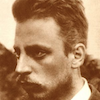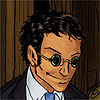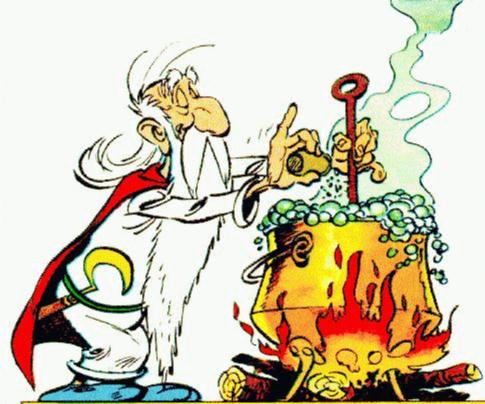The Druids
22 posts •
Page 1 of 1
The Druids
Since it's Halloween time I thought a thread about the Druids wouldn't be a bad idea.This is because the Druids were the ones who gave us Halloween to begin with,after all.
-

mitsuki lover - Posts: 8486
- Joined: Sun Oct 03, 2004 12:00 pm
Imma druid  I enjoy turning into kitties and bears
I enjoy turning into kitties and bears 
 I enjoy turning into kitties and bears
I enjoy turning into kitties and bears 
神 は、 その 独り 子 を お与え に なった ほど に 世 お愛 された。
独り 子 を 信じる 者 が 一人 も滅 ひない で, 永遠 の 命 お得る ため で ある。
ヨハネ 3:16

独り 子 を 信じる 者 が 一人 も滅 ひない で, 永遠 の 命 お得る ため で ある。
ヨハネ 3:16

-

Tenshi no Ai - Posts: 4789
- Joined: Fri Jul 02, 2004 11:01 am
- Location: l
In ancient times, hundreds of years before the dawn of history, there lived a strange race of people...the Druids.
No one knows who they were, or what they were doing, but their legacy remains... hewn into the living rock... of Stonehenge...
No one knows who they were, or what they were doing, but their legacy remains... hewn into the living rock... of Stonehenge...


[font="Book Antiqua"][color="Purple"]For the love of Christ controls us, having concluded this: that one died for all, therefore all died; and he that died for all, so that they who live might no longer live for themselves, but for Him who died and rose again on their behalf. II Corinthians 5:14-15[/color][/font]
-

Blitzkrieg1701 - Posts: 1884
- Joined: Wed Jun 02, 2004 9:01 am
- Location: Washington, DC (when I'm not in an alternate universe)
You must realize that they were pagan religious leaders.
RESPECT THE UNBORN AND CHOOSE LIFE...your mother did.
"Do not underestimate the power of the muffin! The muffin will smite all those who question it! The muffin will crush all nay-sayers! He who controls the muffin shall control the entire world!" -Taishi, Comic Party English Dub
"Do not underestimate the power of the muffin! The muffin will smite all those who question it! The muffin will crush all nay-sayers! He who controls the muffin shall control the entire world!" -Taishi, Comic Party English Dub
-

AsianBlossom - Posts: 1376
- Joined: Tue Feb 27, 2007 12:00 pm
- Location: *staaaaaaaaaaaaaaaare*
I have relatively little to say about the Druids, other than that they are one of many mystic priest classes that are given far too much attention today. But I have to post because:
Getafix was one of the last people I expected to see on CAA. He's not a meme, is he?
Fish and Chips wrote:
Getafix was one of the last people I expected to see on CAA. He's not a meme, is he?
-

uc pseudonym - Posts: 15506
- Joined: Tue Jun 10, 2003 4:00 am
- Location: Tanzania
uc pseudonym wrote:Getafix was one of the last people I expected to see on CAA. He's not a meme, is he?
No.
No he is not.
Yet.
-

Fish and Chips - Posts: 4415
- Joined: Sat Dec 16, 2006 2:33 pm
- Location: Nowhere.
Yes they were Pagan,but as I said they were the ones who started Halloween.
The Romans hated the Druids mainly because they were the ones who were always encouraging the Celts to try to regain their freedoms.
Merlin is supposed to been one.
The Romans hated the Druids mainly because they were the ones who were always encouraging the Celts to try to regain their freedoms.
Merlin is supposed to been one.
-

mitsuki lover - Posts: 8486
- Joined: Sun Oct 03, 2004 12:00 pm
mitsuki lover wrote:Yes they were Pagan,but as I said they were the ones who started Halloween.
Might I add that the Mexicans had something to do with it too, contributing with their Day of the Dead?
神 は、 その 独り 子 を お与え に なった ほど に 世 お愛 された。
独り 子 を 信じる 者 が 一人 も滅 ひない で, 永遠 の 命 お得る ため で ある。
ヨハネ 3:16

独り 子 を 信じる 者 が 一人 も滅 ひない で, 永遠 の 命 お得る ため で ある。
ヨハネ 3:16

-

Tenshi no Ai - Posts: 4789
- Joined: Fri Jul 02, 2004 11:01 am
- Location: l
-

Mr. SmartyPants - Posts: 12541
- Joined: Sat Aug 21, 2004 9:00 am
Mr. SmartyPants wrote:You forgot Moonkin.
Feral, not balance. But I CAN be a sea lion... OH and a birdy!
神 は、 その 独り 子 を お与え に なった ほど に 世 お愛 された。
独り 子 を 信じる 者 が 一人 も滅 ひない で, 永遠 の 命 お得る ため で ある。
ヨハネ 3:16

独り 子 を 信じる 者 が 一人 も滅 ひない で, 永遠 の 命 お得る ため で ある。
ヨハネ 3:16

-

Tenshi no Ai - Posts: 4789
- Joined: Fri Jul 02, 2004 11:01 am
- Location: l
Sadly I could not see the picture of the Great Druid Getafix. But it's glad to hear his name mentioned. Off course he also go by the name of Panoramix (his original French name if I'm not mistaken) but I've always known him as Getafix. You got to admire any druid who can survive being hit by a menhir twice!
Unwise Toasting Sermon
The Sweet Smell of CAA
The Avatar Christian Ronin designed for me
An Avatar KhakiBlue gave to me
The avatar Termyt made for me
Current Avatar by SirThinks2much - thank you very much! :)
:)
The Sweet Smell of CAA
The Avatar Christian Ronin designed for me
An Avatar KhakiBlue gave to me
The avatar Termyt made for me
KhakiBlueSocks wrote:"I'm going to make you a prayer request you can't refuse..." Cue the violins.
Current Avatar by SirThinks2much - thank you very much!
 :)
:)-

bigsleepj - Posts: 3432
- Joined: Sun Apr 11, 2004 12:00 pm
- Location: South Africa - Oh yes, better believe it!
Tenshi no Ai wrote:Feral, not balance. But I CAN be a sea lion... OH and a birdy!
Pft, I don't know the Druid specs. XD Leave me alone.
-

Mr. SmartyPants - Posts: 12541
- Joined: Sat Aug 21, 2004 9:00 am
Mr. SmartyPants wrote:Pft, I don't know the Druid specs. XD Leave me alone.
They got a lot better after the switch to 3rd edition.
The scientific method," Thomas Henry Huxley once wrote, "is nothing but the normal working of the human mind." That is to say, when the mind is working; that is to say further, when it is engaged in corrrecting its mistakes. Taking this point of view, we may conclude that science is not physics, biology, or chemistry—is not even a "subject"—but a moral imperative drawn from a larger narrative whose purpose is to give perspective, balance, and humility to learning.
Neil Postman
(The End of Education)
Anti-intellectualism has been a constant thread winding its way through our political and cultural life, nurtured by the false notion that democracy means that my ignorance is just as good as your knowledge
Isaac Aasimov
Neil Postman
(The End of Education)
Anti-intellectualism has been a constant thread winding its way through our political and cultural life, nurtured by the false notion that democracy means that my ignorance is just as good as your knowledge
Isaac Aasimov
-

Technomancer - Posts: 2379
- Joined: Fri Jun 13, 2003 11:47 am
- Location: Tralfamadore
Funny. Y'all don't look Druish... *badum-tish*
The cake used to be a lie like you, but then it took a portal to the deception core.
-

Kaligraphic - Posts: 2002
- Joined: Wed Jul 21, 2004 12:00 pm
- Location: The catbox of DOOM!
Mr. SmartyPants wrote:You forgot Moonkin.
Moonkin becomes BOOMKIN!
I've got a very good friend of mine that claims druidism as his faith. He's lighting a fire for a hallows eve vigil/ceremony. I've always been curious about his connection to the historic druids.
-

Etoh*the*Greato - Posts: 2618
- Joined: Tue Feb 20, 2007 12:46 pm
- Location: Missouri
Etoh*the*Greato wrote:Moonkin becomes BOOMKIN!
I've got a very good friend of mine that claims druidism as his faith. He's lighting a fire for a hallows eve vigil/ceremony. I've always been curious about his connection to the historic druids.
Essentially none. Druidism as it is practiced today is largely the invention of a few 19th century Englishman. The druids themselves left no written records.
The scientific method," Thomas Henry Huxley once wrote, "is nothing but the normal working of the human mind." That is to say, when the mind is working; that is to say further, when it is engaged in corrrecting its mistakes. Taking this point of view, we may conclude that science is not physics, biology, or chemistry—is not even a "subject"—but a moral imperative drawn from a larger narrative whose purpose is to give perspective, balance, and humility to learning.
Neil Postman
(The End of Education)
Anti-intellectualism has been a constant thread winding its way through our political and cultural life, nurtured by the false notion that democracy means that my ignorance is just as good as your knowledge
Isaac Aasimov
Neil Postman
(The End of Education)
Anti-intellectualism has been a constant thread winding its way through our political and cultural life, nurtured by the false notion that democracy means that my ignorance is just as good as your knowledge
Isaac Aasimov
-

Technomancer - Posts: 2379
- Joined: Fri Jun 13, 2003 11:47 am
- Location: Tralfamadore
I've always wondered about the fascination with Druids.
Sure, we like Pirates and Ninjas and Jesse James and I don’t really know why that is, either, except to say that Americans like underdogs and enjoy romanticizing stories about the under-privileged in society sticking it to the man. The druids, however, weren’t just pro-establishment, they were the establishment. Perhaps all that is not Christian today just seems like a cool antiestablishment alternative regardless if they are understood or not.
Sure, we like Pirates and Ninjas and Jesse James and I don’t really know why that is, either, except to say that Americans like underdogs and enjoy romanticizing stories about the under-privileged in society sticking it to the man. The druids, however, weren’t just pro-establishment, they were the establishment. Perhaps all that is not Christian today just seems like a cool antiestablishment alternative regardless if they are understood or not.
[color="Red"]Please visit Love146.org[/color]
A member of the Society of Hatted Members

If your pedantic about grammar, its unlikely that you'll copy and paste this into your sig, to.
A member of the Society of Hatted Members

If your pedantic about grammar, its unlikely that you'll copy and paste this into your sig, to.
-

termyt - Posts: 4289
- Joined: Sat Jun 26, 2004 12:00 pm
- Location: oHIo
The only records we have are what Caesar and other Roman commentators wrote,and as I pointed out they weren't exactly objective.
-

mitsuki lover - Posts: 8486
- Joined: Sun Oct 03, 2004 12:00 pm
There are also Irish sources, but these are often mythic and form, and as a result less historical.
The scientific method," Thomas Henry Huxley once wrote, "is nothing but the normal working of the human mind." That is to say, when the mind is working; that is to say further, when it is engaged in corrrecting its mistakes. Taking this point of view, we may conclude that science is not physics, biology, or chemistry—is not even a "subject"—but a moral imperative drawn from a larger narrative whose purpose is to give perspective, balance, and humility to learning.
Neil Postman
(The End of Education)
Anti-intellectualism has been a constant thread winding its way through our political and cultural life, nurtured by the false notion that democracy means that my ignorance is just as good as your knowledge
Isaac Aasimov
Neil Postman
(The End of Education)
Anti-intellectualism has been a constant thread winding its way through our political and cultural life, nurtured by the false notion that democracy means that my ignorance is just as good as your knowledge
Isaac Aasimov
-

Technomancer - Posts: 2379
- Joined: Fri Jun 13, 2003 11:47 am
- Location: Tralfamadore
The Druids stuffed criminals in giant wicker men and set them aflame for punishment. I know this because Caesar said so. They also hunt elk that have no knee joints.
-

Puguni - Posts: 1323
- Joined: Fri Mar 25, 2005 4:13 pm
- Location: In a place where I can wonder why good grammar doesn't apply on the internet.
Here's what the History Channel has to say:
Halloween's origins date back to the ancient Celtic festival of Samhain (pronounced sow-in).
The Celts, who lived 2,000 years ago in the area that is now Ireland, the United Kingdom, and northern France, celebrated their new year on November 1. This day marked the end of summer and the harvest and the beginning of the dark, cold winter, a time of year that was often associated with human death. Celts believed that on the night before the new year, the boundary between the worlds of the living and the dead became blurred. On the night of October 31, they celebrated Samhain, when it was believed that the ghosts of the dead returned to earth. In addition to causing trouble and damaging crops, Celts thought that the presence of the otherworldly spirits made it easier for the Druids, or Celtic priests, to make predictions about the future. For a people entirely dependent on the volatile natural world, these prophecies were an important source of comfort and direction during the long, dark winter.
To commemorate the event, Druids built huge sacred bonfires, where the people gathered to burn crops and animals as sacrifices to the Celtic deities.
During the celebration, the Celts wore costumes, typically consisting of animal heads and skins, and attempted to tell each other's fortunes. When the celebration was over, they re-lit their hearth fires, which they had extinguished earlier that evening, from the sacred bonfire to help protect them during the coming winter.
By A.D. 43, Romans had conquered the majority of Celtic territory. In the course of the four hundred years that they ruled the Celtic lands, two festivals of Roman origin were combined with the traditional Celtic celebration of Samhain.
The first was Feralia, a day in late October when the Romans traditionally commemorated the passing of the dead. The second was a day to honor Pomona, the Roman goddess of fruit and trees. The symbol of Pomona is the apple and the incorporation of this celebration into Samhain probably explains the tradition of "bobbing" for apples that is practiced today on Halloween.
By the 800s, the influence of Christianity had spread into Celtic lands. In the seventh century, Pope Boniface IV designated November 1 All Saints' Day, a time to honor saints and martyrs. It is widely believed today that the pope was attempting to replace the Celtic festival of the dead with a related, but church-sanctioned holiday. The celebration was also called All-hallows or All-hallowmas (from Middle English Alholowmesse meaning All Saints' Day) and the night before it, the night of Samhain, began to be called All-hallows Eve and, eventually, Halloween. Even later, in A.D. 1000, the church would make November 2 All Souls' Day, a day to honor the dead. It was celebrated similarly to Samhain, with big bonfires, parades, and dressing up in costumes as saints, angels, and devils. Together, the three celebrations, the eve of All Saints', All Saints', and All Souls', were called Hallowmas.
Beyond all these things put on love, which is the perfect bond of unity.
Colossians 3:14
~ my personal website ~
Colossians 3:14
~ my personal website ~
-

Kat Walker - Posts: 321
- Joined: Sat Aug 09, 2003 3:40 pm
22 posts •
Page 1 of 1
Who is online
Users browsing this forum: No registered users and 273 guests







